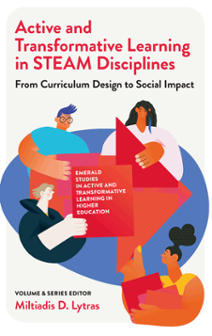
Index
Active and Transformative Learning in STEAM Disciplines
ISBN: 978-1-83753-619-1, eISBN: 978-1-83753-618-4
Publication date: 20 November 2023
Citation
(2023), "Index", Lytras, M.D. (Ed.) Active and Transformative Learning in STEAM Disciplines (Emerald Studies in Active and Transformative Learning in Higher Education), Emerald Publishing Limited, Leeds, pp. 297-306. https://doi.org/10.1108/978-1-83753-618-420231018
Publisher
:Emerald Publishing Limited
Copyright © 2024 Miltiadis D. Lytras. Published under exclusive licence by Emerald Publishing Limited
INDEX
- Prelims
- Introduction: Active and Transformative Learning (ATL) as a New Higher Educational Paradigm
- Chapter 1 Active and Transformative Learning (ATL) in Higher Education in Times of Artificial Intelligence and ChatGPT: Investigating a New Value-Based Framework
- Chapter 2 Educational Sustainability for Transforming Education: A New Approach of Active Learning in an Interdisciplinary Program in Higher Education
- Chapter 3 Transformative Active Learning in the Saudi National Institute of Health: Promoting Education and Research Skills Capability
- Chapter 4 Practical Applicability of Active Learning Strategies for Stimulating Engagement Among Economics Students: The Post-Pandemic Outlook
- Chapter 5 Historic Learning Analytics Transforming Learning in Saudi Arabian Higher Education
- Chapter 6 From Passive to Active Learning: The Transformative Power of Writing in Higher Education
- Chapter 7 Transformative Learning Strategies for Successful Teaching and Learning in the Transforming Higher Education
- Chapter 8 Innovative Hybrid Learning: A New Paradigm in Teacher Education for Transformative Learning
- Chapter 9 How a Hybrid Education Model Can Support the COVID-19 Sanitary Emergency Based on Information and Communication Technologies
- Chapter 10 Adopting HyFlex Course Design: Actions for Policymakers, Researchers, and Practitioners
- Chapter 11 Blended Learning as the Baseline for Post-COVID-19 Higher Education
- Chapter 12 Seeking Motivation for the Success of Active Learning
- Chapter 13 Implementation of a High School Equivalency Policy in an Active Learning Environment: A Case Study of US-Curriculum School in the United Arab Emirates
- Chapter 14 An Integrated Transformative Learning Strategy at National Level: Bold Initiatives Toward Vision 2030 in Saudi Arabia
- Index